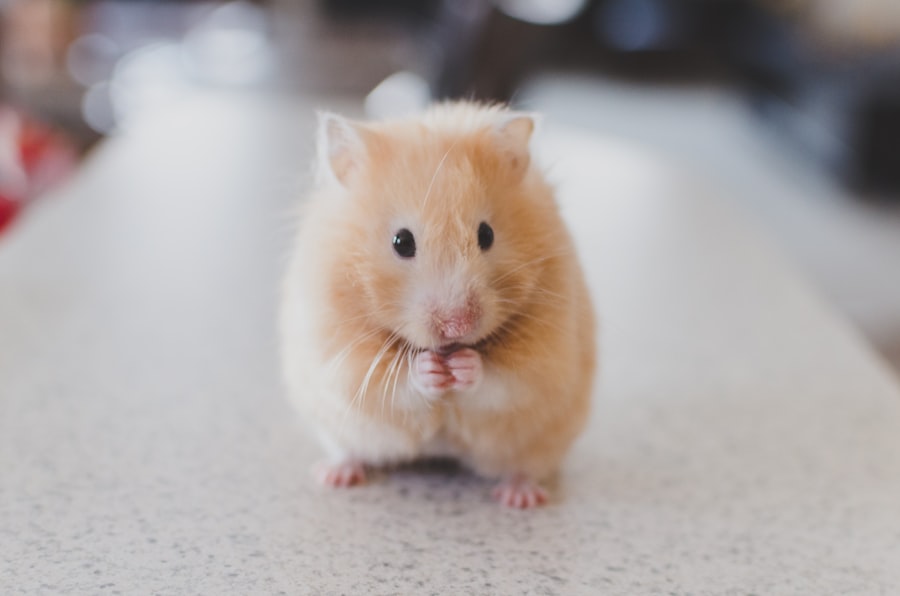
21 Sep
Revolutionary Cage: Is Your Hamster Unhappy?
Hamsters, like other animals, exhibit specific behaviors that indicate their emotional state and overall well-being. It is crucial for hamster owners to recognize signs of distress or unhappiness in their pets to ensure proper care and quality of life. Common indicators of an unhappy hamster include:
1.
Excessive grooming or self-mutilation, resulting in bald patches or sores
2. Decreased appetite or weight loss
3. Aggressive behavior, such as biting or excessive chewing on cage bars
4.
Excessive sleeping or lethargy beyond normal daytime rest periods
5. Lack of interest in activities or interaction
6. Repetitive behaviors, like pacing or circling in their cage
These behaviors may signify stress, frustration, depression, or boredom.
Hamster owners should remain vigilant and attentive to their pet’s behavior to identify any signs of unhappiness promptly. If concerning symptoms persist, it is advisable to seek veterinary consultation. By recognizing these signs early, hamster owners can take proactive measures to improve their pet’s environment, diet, or overall care, ensuring a happier and more fulfilling life for their small companion.
Key Takeaways
- Signs of an Unhappy Hamster: Watch for excessive grooming, aggression, or hiding as signs of unhappiness in your hamster.
- The Importance of Cage Size and Design: A spacious and well-designed cage is crucial for your hamster’s physical and mental well-being.
- The Role of Enrichment and Toys in a Hamster’s Well-being: Providing a variety of toys and enrichment activities is essential for keeping your hamster mentally stimulated and happy.
- Understanding the Impact of Noise and Disturbances on Hamsters: Loud noises and disturbances can cause stress and anxiety in hamsters, so it’s important to create a quiet and calm environment for them.
- The Relationship Between Socialization and a Hamster’s Happiness: While hamsters are solitary animals, they still benefit from gentle and consistent socialization with their owners.
- Tips for Creating a Happy and Healthy Environment for Your Hamster: Provide a balanced diet, regular exercise, and a clean living environment to ensure your hamster’s happiness and health.
- Seeking Professional Help for Your Hamster’s Mental Health: If you notice any concerning behavior in your hamster, don’t hesitate to seek professional help from a veterinarian or animal behaviorist.
The Importance of Cage Size and Design
Providing Space for Exploration and Exercise
A larger cage allows for more room to explore, exercise, and engage in natural behaviors, which are essential for a hamster’s well-being. A well-designed cage with multiple levels, tunnels, and hiding spots can provide mental stimulation and enrichment for hamsters, preventing boredom and promoting a sense of security.
The Importance of Bedding and Substrate
The type of bedding and substrate used in the cage can also impact a hamster’s well-being. Soft, natural bedding materials such as paper-based bedding or aspen shavings provide a comfortable and safe environment for hamsters to burrow and nest in.
Maintenance and Hygiene
It’s essential for hamster owners to regularly clean and maintain the cage to ensure a hygienic and odor-free environment for their pets. By providing a spacious, well-designed cage with appropriate bedding and substrate, hamster owners can create a comfortable and enriching environment that promotes their pet’s happiness and well-being.
The Role of Enrichment and Toys in a Hamster’s Well-being

Enrichment and toys play a crucial role in promoting a hamster’s mental and physical well-being. Hamsters are naturally curious and active animals that require mental stimulation and physical exercise to thrive. Providing a variety of toys, such as tunnels, chew toys, exercise wheels, and hideouts, can help prevent boredom and encourage natural behaviors in hamsters.
Additionally, rotating and introducing new toys regularly can keep hamsters engaged and prevent them from becoming bored with their environment. Furthermore, providing opportunities for foraging and food enrichment can also promote a hamster’s well-being. Scatter feeding or using puzzle feeders can encourage natural foraging behaviors in hamsters, providing mental stimulation and preventing boredom.
It’s important for hamster owners to provide a variety of enrichment activities and toys to keep their pets mentally engaged and physically active. By incorporating enrichment activities and toys into their pet’s daily routine, hamster owners can promote their pet’s happiness and overall well-being.
Understanding the Impact of Noise and Disturbances on Hamsters
| Experiment | Noise Level (dB) | Disturbance Frequency | Hamster Activity Level |
|---|---|---|---|
| Control Group | 40 | None | Normal |
| Group 1 | 60 | Low | Reduced |
| Group 2 | 80 | Medium | Decreased |
| Group 3 | 100 | High | Minimal |
Hamsters are sensitive animals that can be easily stressed by loud noises and disturbances in their environment. Excessive noise from household appliances, loud music, or frequent disturbances can cause stress and anxiety in hamsters, leading to negative impacts on their mental well-being. It’s important for hamster owners to create a quiet and peaceful environment for their pets in order to promote their happiness and reduce stress.
Additionally, sudden movements or handling can also cause stress in hamsters. It’s important for hamster owners to handle their pets gently and with care in order to build trust and prevent stress. Providing a quiet and calm environment with minimal disturbances can help promote a hamster’s mental well-being and overall happiness.
By understanding the impact of noise and disturbances on hamsters, owners can take proactive steps to create a peaceful environment that promotes their pet’s well-being.
The Relationship Between Socialization and a Hamster’s Happiness
While hamsters are solitary animals that prefer to live alone, they still require socialization and interaction with their owners in order to thrive. Regular handling, gentle interaction, and bonding time with their owners can help prevent loneliness and promote a hamster’s happiness. It’s important for hamster owners to spend quality time with their pets, providing opportunities for gentle handling, bonding, and playtime.
Additionally, providing opportunities for mental stimulation through interactive toys and enrichment activities can also promote a hamster’s happiness. By engaging in regular interaction with their owners and providing opportunities for mental stimulation, hamsters can lead happy and fulfilling lives. It’s important for hamster owners to understand the importance of socialization in promoting their pet’s happiness and well-being.
Tips for Creating a Happy and Healthy Environment for Your Hamster

Providing a Comfortable Living Space
Start by providing a spacious cage with multiple levels, tunnels, hiding spots, and appropriate bedding materials to create a comfortable and enriching environment for your pet. Regularly clean and maintain the cage to ensure a hygienic and odor-free environment.
Mental Stimulation and Enrichment
Incorporate a variety of toys, such as tunnels, chew toys, exercise wheels, and hideouts, into your pet’s environment to promote mental stimulation and prevent boredom. Rotate and introduce new toys regularly to keep your hamster engaged. Additionally, provide opportunities for foraging and food enrichment through scatter feeding or puzzle feeders to encourage natural behaviors.
Building Trust and Reducing Stress
Handle your pet gently and with care to build trust and prevent stress. Spend quality time with your pet through regular interaction, gentle handling, bonding time, and playtime to prevent loneliness and promote happiness. Create a quiet and peaceful environment with minimal disturbances to reduce stress and anxiety in your pet.
Seeking Professional Help for Your Hamster’s Mental Health
If you notice any concerning signs of unhappiness or behavioral changes in your hamster, it’s important to seek professional help from a veterinarian with experience in small animal care. A veterinarian can conduct a thorough examination to rule out any underlying health issues that may be causing distress in your pet. Additionally, they can provide guidance on creating an enriching environment, handling techniques, socialization tips, and other aspects of care that can promote your pet’s mental health.
In some cases, a veterinarian may recommend consulting with an animal behaviorist or specialist who can provide further insight into your pet’s behavior and well-being. By seeking professional help when needed, you can ensure that your hamster receives the care and support they need to lead a happy and fulfilling life. In conclusion, creating a happy and healthy environment for your hamster involves providing the right housing, enrichment, socialization, care, as well as seeking professional help when needed.
By being attentive to your pet’s behavior and needs, you can take proactive steps to promote their mental health and overall well-being. With the right care and support, you can ensure that your hamster lives a happy and fulfilling life as part of your family.
FAQs
What are signs that my hamster is unhappy?
Some signs that your hamster may be unhappy include decreased activity, loss of appetite, excessive grooming, and aggressive behavior.
How can a cage affect my hamster’s happiness?
The size and layout of a hamster cage can greatly impact your hamster’s happiness. A small, cramped cage can lead to stress and boredom, while a spacious and enriching environment can promote mental and physical well-being.
What features should I look for in a hamster cage to promote happiness?
A good hamster cage should have ample space for your hamster to move around, multiple levels or platforms for climbing and exploring, and various toys and accessories for mental stimulation.
How does the revolutionary cage mentioned in the article improve hamster happiness?
The revolutionary cage mentioned in the article provides a larger living space for hamsters, with multiple levels and tunnels for exploration. It also includes interactive features to keep hamsters mentally engaged and active.
Where can I find this revolutionary hamster cage?
The article should provide information on where to purchase the revolutionary hamster cage, whether it’s available in pet stores, online retailers, or directly from the manufacturer.
Proudly powered byWordPress. Theme byInfigo Software.








